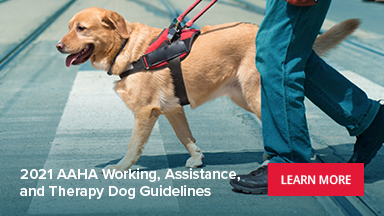AAHA's Working Dog Guidelines Work for You
 What’s the difference between working, assistance, and therapy dogs? Not all working dogs’ jobs are the same—and they often undergo extensive training to meet the rigorous physical and psychological demands placed upon them.
What’s the difference between working, assistance, and therapy dogs? Not all working dogs’ jobs are the same—and they often undergo extensive training to meet the rigorous physical and psychological demands placed upon them.
Your veterinary team can better meet working dogs’ health needs by understanding their different duties and roles.
Learn more about how to care for these special patients in our 2021 AAHA Working, Assistance, and Therapy Dog Guidelines
| Working Dogs | Assistance Dogs | Therapy Dogs |
|---|---|---|
| Trained to accomplish specific, defined tasks | Help persons with a diagnosed psychological or physical limitation who benefit from interaction with a dog | Perform either animal-assisted activities (AAA) or animal-assisted therapy (AAT) |
| Categories of working dogs | Categories of assistance dogs | Categories of therapy dogs |
|
|
|



